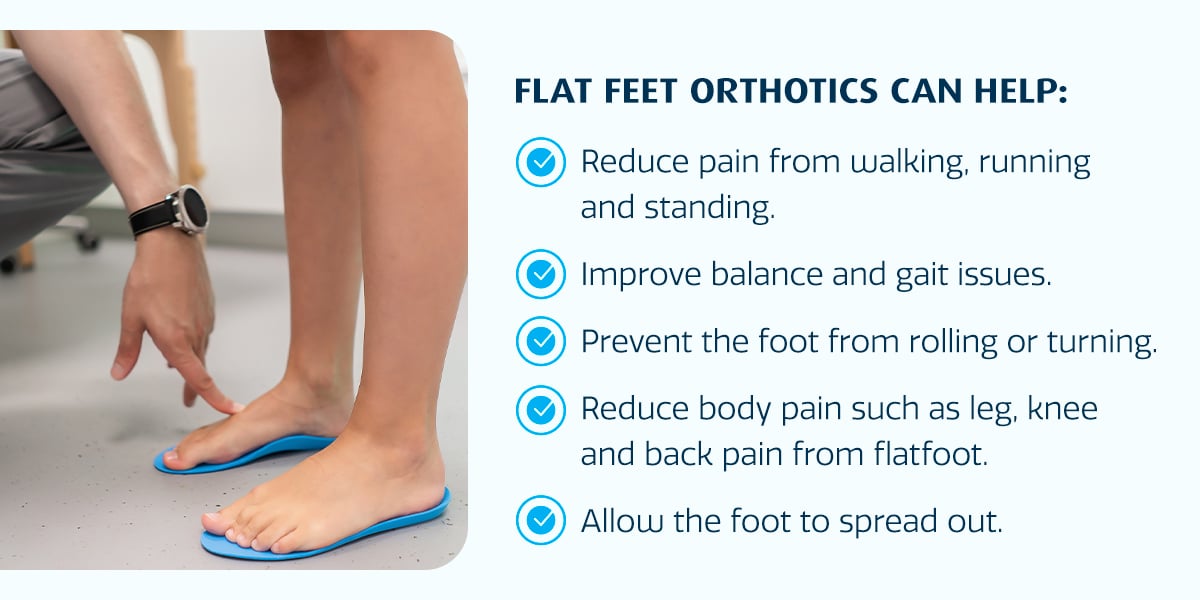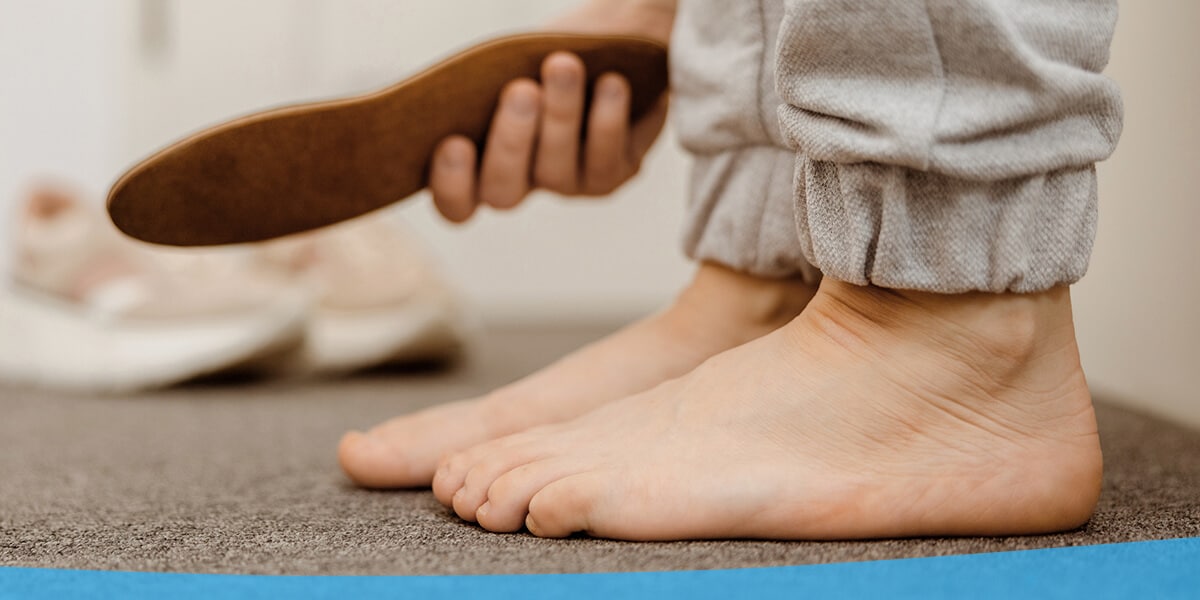When you have flat feet, it can affect how you walk and distribute your weight. Many patients with flat feet experience pain throughout the lower body, ranging from pain in the foot to twisted ankles and back pain. Custom orthotics can significantly reduce pain and discomfort, providing relief for this common condition. They offer a straightforward way to improve quality of life and mobility and prevent more severe problems from developing.
If you have flat feet, consider asking your podiatrist about using orthotics to reduce your symptoms.
What Are Orthotics for Flat Feet?
Orthotics are a type of medical device used to reduce symptoms of a condition or help you function better in day-to-day living. Orthotics for flat feet, also called flatfoot, usually take the form of shoe inserts. They can add cushioning and adjust how your foot absorbs shock or receives pressure from the ground. With these changes, flat feet orthotics often reduce pain and can help with other issues.
By changing the shape of the surface your foot sits on, flat feet orthotics can help:

- Reduce pain from walking, running and standing.
- Improve balance and gait issues.
- Prevent the foot from rolling or turning.
- Reduce body pain such as leg, knee and back pain from flatfoot.
- Allow the foot to spread out.
Many providers prescribe orthotics for flat feet because they’re convenient, affordable and effective. Researchers have found that orthotics significantly reduce pain, especially if used alongside exercise. You can easily slip them into your shoes for a low-maintenance treatment, and they’re relatively affordable. Orthotics may also allow you to avoid more intensive approaches like surgery.
Making custom orthotics for flat feet starts with your provider taking a mold of your foot. This mold allows the manufacturer to create an insert designed for the unique shape of your foot. While you can find over-the-counter orthotics, these products are generally best for people who have developed arches. Over-the-counter orthotics don’t offer the level of support that flat feet need.
What Kind of Orthotics Do I Need for Flat Feet?
When you have flat feet, they experience more force when you stand or walk. Ill-fitting orthotics can push into the foot and actually increase pain. Many people think they need high arches to make up for flat feet, but too-high arches in the orthotics can cause this kind of pain. Narrow orthotics might also cause pain along the inside edge of the orthotic.
On the other end of the spectrum are orthotics without any support. While these products might be easier to wear initially, they won’t prevent pain from flat feet.
The right orthotic for this condition must have an arch wide enough to prevent the foot from pressing on the orthotic’s inner edge. It also needs to fit tightly to the arch. Many off-the-shelf orthotics have a gap between the arch and the foot, so they won’t offer the necessary support.
These requirements offer general guidance on orthotics, but the right kind of insert for you will be one custom-built for your foot and symptoms. Well-selected orthotics made with high-quality material should offer quick pain relief for people with flat feet.
Flat Feet vs. Fallen Arches
Many people refer to flat feet and fallen arches interchangeably, but they have subtle differences. Flat feet can appear in childhood, but fallen arches develop in adulthood. Fallen arches occur when fully developed arches collapse, often due to injuries such as dislocated bones or torn tendons. Age can also cause wear and tear and contribute to fallen arches.
Although fallen arches lead to flat feet, not all cases of flat feet come from fallen arches. Flat feet can simply be inherited.
Orthotic treatment is similar for both conditions and focuses on adding support and reducing symptoms and risk.
Can Flat Feet Be Corrected?
While you can often address the symptoms of flat feet, you generally cannot correct them without surgery. Still, nonsurgical options like orthotics can greatly reduce pain. Orthotics add support to reduce the pressure applied to your foot, but they don’t change the structure of your foot or realign your arches. You will likely need to use orthotics or other treatment options long-term to prevent pain.
Besides orthotics, some of these other nonsurgical options include:
- Physical therapy: With physical therapy for the foot and ankles, you can reduce symptoms by building strength in the ligaments and tendons of the foot. You would perform repetitive exercises to help your feet, and this process can take some time before you see results.
- Pain relieving medication: Taking pain relievers, like ibuprofen or acetaminophen, can help when symptoms flare up.
- Ankle braces: If you frequently roll or sprain your ankle, an ankle brace that supports the arches could help keep it in place.
For severe cases of flatfoot that cause pain, your doctor might suggest surgery. Surgical treatments usually repair tendons or realign bones in your foot. They might fuse bones together to minimize painful movements or create a new arch in your foot.
If you think a child might have flat feet, keep in mind that arches usually form by age 6. Many kids grow out of flatfoot and won’t need any extra support, but you should still have a doctor explore symptoms like pain or gait problems.
Do You Need Orthotics for Flat Feet?
The need for orthotics can vary for each person. Some people don’t have any pain from flat feet. If you don’t have any symptoms, you may not need orthotics, but remember, pain isn’t the only indication of flat feet. Other symptoms of this condition include balance problems or sprains in the ankles or toes. Flat feet can cause you to put more weight on your heels and the balls of your feet, limiting your flexibility and stressing your ankles and toes.
You may also benefit from orthotics if flat feet cause leg, knee, back or hip pain. Since your feet support your body weight, arch issues can affect how you stand or walk, leading to pain in these areas.
Talk to a Provider About Flat Feet Orthotics Today
Flat feet orthotics can be a game-changer for many people dealing with the condition. Whether you know you need orthotics or want to explore your options, always work with a qualified podiatrist.
If you’re near southwest Washington, the experienced team at Foot & Ankle Surgical Associates can help. We can diagnose and treat flat feet and related conditions that could be causing your symptoms. Our orthotics come in many options, and we’ll measure and take a mold of your foot at the office.
Contact us online or call us at 360-754-FEET (360-754-3338) to make your appointment.





